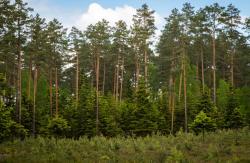 Asset Publisher
Asset Publisher
Polish forests
Poland is in the European lead, while concerning the area of all forests. They cover about 29,2 % of the country territory, and grow within the area of 9,1 million hectares. The overwhelming majority of the forests is state owned, of which almost 7,6 million hectares are managed by the State Forests National Forest Holding..
The number of Polish forest is still growing. The forestation rate of the country has increased from 21 % in 1945 to 29,2 % at the moment. Between 1995 and 2008, the forest area increased by 310 thousand ha. The basis for afforestation works is the "National Programme for Increasing the Forest Cover" (KPZL), assuming an increase of the forestation rate up to 30 % by 2020 and up to 33 % by 2050. Polish forests abound in flora, fauna and fungi. 65 % of the total number of animal species live there.
The forests grow in our country on poor soils, mainly because of the development of the agriculture in previous years. It influences the distribution of the types of the forest sites in Poland. Over 55 % of the forest areas is covered with coniferous forests. In other areas, there are forest sites, mainly the mixed ones. Their small part constitute alder and riparian forests – not more than 3 %.
In the years 1945 – 2011 the area of natural deciduous tree stands within the area of the State Forests National Forest Holding increased from 13 to 28,2 %.
Within the lowlands and uplands the most often occurring tee species is pine. It covers 64,3 % of the forest area of the State Forests National Forest Holding and 57,7 % of private and commune forests. In the mountains the predominant species is European spruce ( in the west) and European spruce with beech (in the east). Domination of pine is the result of carrying on sustainable forest management in the past. Once, the monocultures (crops or cultivations of one species) were the answer to the great demand of industry for wood. Such forests appeared to be quite fragile to climatic factors. They also were often the prey of pests' expansion.
In Polish forests, the share of other tree species, especially deciduous trees have been systematically increasing. The foresters have stepped aside from monocultures – that is why, they try to fit specific species of the forest stand to the natural stand, that would be proper for the given area. Thanks to that, in the years 1945 – 2011, the area of the deciduous tree stands within the lands of the State Forests National Forest Holding increased from 13 to 28,2 %. There occur more and more frequently the following tree species: oaks, ashes, maples, sycamore maples, elms, but also birches, beeches, alders, poplars, hornbeams, aspens, tilias and willows.
Our forests are the most often represented by the forest stands aged 40 to 80 years. The average age of the forest equals 60 years. More and more trees are of big size at the age over 80 years. Since the end of the Second World War, the forests' area has increased up to almost 1,85 million hectares.
Raport o stanie lasów w Polsce 2012
 Asset Publisher
Asset Publisher
 Asset Publisher
Asset Publisher
Lasy Nadleśnictwa Biłgoraj
Lasy Nadleśnictwa Biłgoraj
Nadleśnictwo Biłgoraj swoim zasięgiem obejmuje niemal 17 tyś. ha powierzchni leśnej co stanowi 97% całkowitej powierzchni nadleśnictwa. Sprawuje ponadto nadzór nad ok. 4,2 tyś. ha lasów niestanowiących własności Skarbu Państwa.
Strefa kontaktu Roztocza z Równiną Biłgorajską charakteryzuje się silnymi kontrastami krajobrazu, wynikających z znacznych różnic wysokości, które najbardziej podkreślają lasy rozciągające się u podnóża krawędzi. Rzeźba terenu Równiny Biłgorajskiej jest mało zróżnicowana. Dominują równiny tarasów akumulacyjnych. Monotonny krajobraz urozmaicają wały wydmowe długości kilku kilometrów i wysokości ok. 10 m. Urozmaicenie stanowią także doliny rzek, stawy, łąki, bagna i torfowiska. Na torfowiskach spotyka się w różnym stopniu zarastające torfianki. Na ogół są płytkimi zbiornikami nie przekraczającymi kilku arów powierzchni.
Największą powierzchnie zajmują gleby bielicowe, co stanowi ponad 60% powierzchni, kolejne 25% to gleby rdzawe. Takie podłoże wypełniają głównie bory i bory mieszane o różnym uwilgotnieniu, w których króluje sosna pospolita. Skład gatunkowy drzewostanów na siedliskach borowych jest zbliżony do przyjętych gospodarczych typów drzewostanów, natomiast na siedlisku lasu mieszanego wilgotnego (LMw) dąb zastępowany jest przez jodłę. Pod względem stanu siedliska dominują siedliska naturalne i w stanie zbliżonym do naturalnego, co stanowi 95% powierzchni nadleśnictwa. Siedliska zniekształcone występują na gruntach porolnych.
Charakterystyka roślinności strefowej wg. Matuszkiewicza obejmuje lasy liściaste Querco-Fagetea, głównie w związku Carpinion oraz kontynentalne lasy szpilkowe Vaccinio-Piceetea, przede wszystkim bory i bory mieszane sosnowe ze związku Dicrano-Pinion z pewnym udziałem jodłowych lasów związku Vaccinio-Piceion. Drzewostany nadleśnictwa tworzą 20 gatunków drzew. Gatunkiem głównym jest sosna stanowiąca 92% powierzchni. Gatunek ten osiąga przecietnie I-II bonitację, a drzewostany charakteryzuje się dobrą jakością hodowlaną i techniczną. Kolejnymi gatunkami pod względem udziału powierzchniowego są: olsza, brzoza i jodła. Pozostałymi gatunkami rodzimymi są: świerk, dąb szypułkowy i bezszypułkowy, modrzew, buk, klon jawor, jesion zwyczajny, grab pospolity, osika i lipa drobnolistna. Wśród gatunków obcego pochodzenia występuje dąb czerwony, czeremcha amerykańska i robinia akacjowa. W podszycie wśród roślin charakterystycznych występuje trzmielina, kruszyna i leszczyna. Rośliny runa to głównie borówka. Z lasem ściśle wiąże się także świat zwierząt. W lasach naszego nadleśnictwa można spotkać, jelenie sarny daniele, w terenach bardziej podmokłych łosie. Wśród drapieżników występuje wilk, jenot i lis, a z mniejszych m.in. łasica i kuna. To także teren lęgowy dla ptactwa.
Celem gospodarki leśnej jest zachowanie warunków do trwałej wielofunkcyjności lasów ich wszechstronnej użyteczności oraz kształtowania środowiska leśnego. Połowa lasów w naszym nadleśnictwie pełni funkcję ochronną. Pod tym pojęciem kryje się ochrona bioróżnorodności biologicznej, wody przed zanieczyszczeniem, gleby przed erozją i osuwiskami, środowiska naturalnego przed hałasem, powodzią czy wiatrem. 4% lasów nadleśnictwa pełni rolę ostoi zwierząt. Ponadto występują lasy nasienne stanowiące 0,13% powierzchni. Największą grupę lasów ochronnych stanowią lasy wodochronne, bo aż 84,4% powierzchni.


 fot. Paweł Fabijański
fot. Paweł Fabijański
 fot. Paweł Fabijański
fot. Paweł Fabijański
 fot. Paweł Fabijański
fot. Paweł Fabijański









